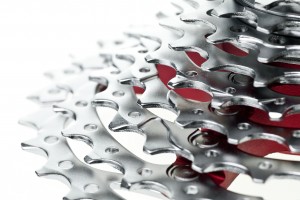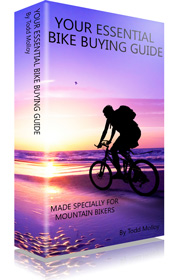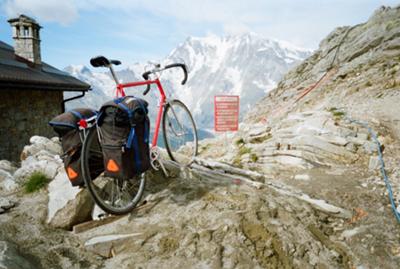Mountain Bike Components

When looking at mountain bike components there are literally thousands of combinations you can have. Just think about all the different components there are…
- Forks
- Brakes
- Front and rear derailleurs
- Bottom brackets
- Cassettes, chains & chairings
- Crank sets
- Handlebars & grips
- Headsets
- Stems
- Shifters
- Wheelsets
- Tires & tubes
- The list goes on…
It is practically impossible to compare 2 mountain bikes component to component!
At this point of time you should already know:
- What bike type you are going to get
- If you are going to go for a full suspension bike or a hardatil and
- Approximately how much you are willing to spend.
 If You haven’t worked all of these out then click back to return to step 5.
If You haven’t worked all of these out then click back to return to step 5.
Now you are really getting into the nitty gritty of how to buy a mountain bike and need to start looking at what bike components you get with your bike.
Unless you are building your own bike, nearly all bikes will come as complete sets ready to ride. Given the huge number of bike components and variations you can experience I suggest that you stay focussed and stick to the important ones and then make sure the rest fall within some sort of minimums for your price range.
I suggest that you pick 3 or 4 major mountain bike components and then focus on them. For me the big 4 are:
Forks
Just about every mountain bike these days comes with front suspension forks and they are the most important mountain bike components you should look at. If the bike you are looking at does not have front suspension forks you are probably looking at a hybrid, a touring bike or a road bike.
Coil Sprung Forks
In general a coil fork is ideal if you have a tight budget or are after an all round bike. They are your most reliable choice and are more easily serviced. They are easily adjusted and tuned.
The main downside is the extra weight they have due to the steel spring inside the fork. However this also means they are usually made tougher. If you want to do DH racing, lots of jumping or just like to throw your bike around then this is the fork for you.
Air Sprung Forks
Air sprung forks are lighter than coils but are also more expensive. These days they are getting more reliable and are a great choice for a XC rider or someone who wants LOTS of adjustability on their fork.
As long as you have a shock pump you can change your air sprung fork from 0psi to around 300psi in very little time.
Preload
A coil sprung fork will come with a minimum preload on it. If you turn the grooved cap at the top of the fork clockwise you can add preload to it. This means that the spring is being pressed down and makes your fork feel firmer.
Rebound
Rebound is the speed at which your fork springs back up when you push it down. It is good if your fork has a rebound adjuster but not essential. More advanced riders like to set their own rebound but if you are only an amateur rider you will be fine with the factory settings.
Many suspension forks these days can now be adjusted by changing the oil weight in the fork legs. A little dial on the fork is much easier but only more expensive forks will have this.
Compression
This is the opposite of rebound and is the speed at which the fork goes on the way down. You won’t find too many forks that let you adjust this so don’t worry about it too much. As long as your fork is set-up for your weight you don’t need to worry about compression much more.
Brands
When looking at mountain bike components, and in particular forks, I would stick to the major brands like Rock Shox, Fox, Manitou and Marzocchi. They have more money and build better and more reliable forks.
Other Considerations
If your bike does not have disc brakes, keep in mind that you might want to upgrade to disc brakes in the future so look for disc brake mounts.
Wheels
Your bikes wheels are important because the better quality wheels you get (this includes hubs, rims, spokes and tires) the better your ride will be. The more you spend the better your wheels will be, but look at these key areas:
Weight
Obviously the lighter the better. The weight in wheels is rotational mass so it counts double and lighter wheels will make a big difference out on the trail.
Tyre Quality
Again the more you spend the better the quality. Look for a reputable brand and a tyre that is durable and will last you a long time.
Tread Pattern
Depending on what surface you plan to ride on will determine your tread pattern. Smooth semi-slicks for riding on paths and big knobbly tyres for gravel and rough terrain.
Rear Derailleur
Shimano and sram are the big 2 and it is pretty easy to see what you are getting. Again the more you spend the better the quality.
The rank of Shimano mountain bike components is (from best to worst):
- XTR
- Deore XT
- Deore LX
- Deore
- Alivio
- Altus
SRAM offer parts under several different brandnames:
- Shifters, Chains, Cassettes – SRAM
- Brake Callipers – Avid
- Cranksets – Truvativ
The rank of SRAM mountain bike components is (from best to worst):
- X-0
- X-9
- X-7
- SX-5
- SX 4
- 3.0
Specialist Groupsets
Shimano also have the following specialist groupsets (that are very good and recommended if this applies to you):
- Shimano Hone – Enduro and Freeride applications
- Shimano Saint – Downhill and heavy-duty applications
Brakes
when it comes to looking at mountain bike components, brakes are secondary because whilst they are important, they are also easily upgraded. That said, if you can get a bike with hydraulic disc brakes then do it. If not go for mechanical disc brakes. If you are on a really tight budget then you will have to settle for v-brakes and mechanical pull brakes.
Again try to stick with the major players like Hayes, Avid, and Shimano (although there are a couple of other good manufacturers around)
Want to Find Your Perfect Bike?

Want to buy a mountain bike? Then you must check out Your Essential Bike Buying Guide. It will take you step-by-step on the process of finding your perfect bike (and saving $$ in the process). Find out more.






